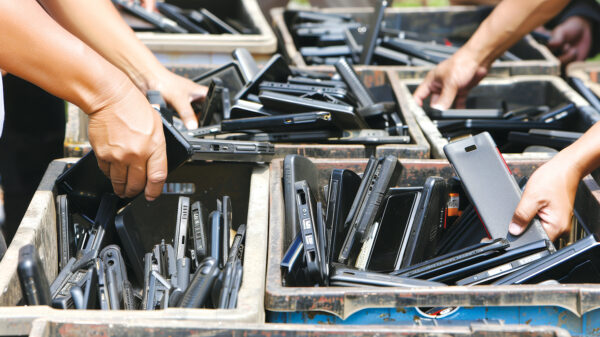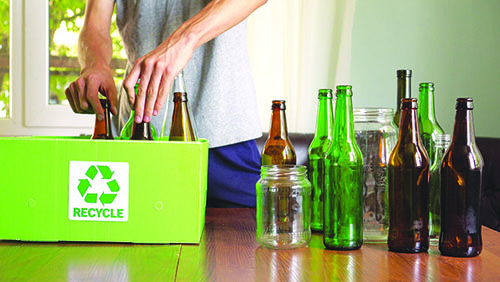by MAURA KELLER
Today’s smart waste and recycling management technologies are truly that: smart. Thanks in part to significant technical advancements, AI technology and the Internet of Things (IoT) are resonating with recycling industries professionals at a growing rate.

“The biggest impact of AI and IoT on the waste management industry is the invention and adoption of smart bins – their ability to report fill levels in real-time have become the critical centerpiece of IoT-enabled waste collection and disposal processes,” said Fabian Kochem, head of global product strategy at 1NCE, an IoT connectivity and software company. “This capability, combined with AI algorithms, enables communities to plan the most optimized pickup routes, reducing fuel consumption and CO2 emissions. Studies have found that the use of Smart Bins reduces collection trips and distance travel by half, resulting in a 30 percent reduction in fuel consumption.”
Quite simply, waste is not being sorted manually anymore, but instead AI-powered robotic arms are being used to separate recyclable from non-recyclable materials faster and with fewer errors. As Kochem explained, due to high precision in detection and analysis, recycling facilities can operate at much higher efficiency and see a significant increase in the number of materials recycled.
“AI and IoT have really increased the efficiency of the industry by digitizing formerly manual operations. Due to real-time IoT data and AI, the industry has been enabled to sustainably optimize entire waste collection, disposal, and recycling processes,” Kochem said. As he explained, this development has allowed the industry to operate at significantly lower costs. Furthermore, it has led to large advances in recycling productivity, generating more output from less waste, which is a very important factor for tackling today’s challenges of climate change.
Carling Spelhaug, senior marketing communications manager at AMP Robotics, explained that AI can learn to identify anything a person can be taught to identify. It can identify brands, form factors, certain types of damage, etc. This provides an entirely new dimension to sorting capabilities. AI then digitizes an image of each item it sees on a conveyor belt.
“AI can record the number of items of a desired commodity type and derive additional data from those objects,” Spelhaug said. “This capability, combined with the mass of produced scrap bales, can offer detailed insights into the trends of a specific material flow – say PET bottles or PET thermoforms – in a given materials recovery facility (MRF), a network of MRFs, or even across a geography. This is powerful data for planning and understanding the supply of desired materials.”
At the facility level, Spelhaug explained that the data AI generates can help recyclers scrutinize their operations, identify inefficiencies and take instantaneous action to rectify them. AI-driven material characterization solutions provide actionable, data-driven insights throughout the facility and provide the tools necessary to centralize data collection and reporting.
For AMP Robotics robots, while it depends on the facility and how many shifts it runs, costs can drop by as much as 50 percent or even 70 percent by replacing hard-to-secure human labor in various sorting roles. “AI-driven automation also produces a higher-quality end product, increasing revenue opportunities for the facility,” Spelhaug said. “AI can be deployed without changing the industry or any one facility’s way of doing business.”
Moreover, AI significantly decreases the cost of measuring what’s happening in a facility. “Each AI sensor can identify nearly all the different material types that are of interest,” Spelhaug said.
And when it comes to sorting, AI is the enabling technology essential for materials recovery facilities (MRFs) to generate and capture data to optimize recycling operations. According to Spelhaug, vision-based AI software identifies and characterizes objects in real time, digitizing each item that passes by. These items are captured as a new form of data, including object counts, packaging descriptions, and more.
“AI is helping the industry overcome inconsistent access to and use of recycling data.” Spelhaug said. “AI and computer vision can identify and describe the objects that pass through MRFs and transform them, both desired commodities and undesired contaminants, into data. Digitizing the waste stream provides transparency about what is and isn’t getting recycled to create better solutions on the path toward a circular economy.”
Key Areas of Success
Stacy Savage, founder and chief executive officer of Zero Waste Strategies LLC, pointed to several key areas within the recycling industry where AI and IoT is having a significant impact.
- Predictive maintenance – Once an AI system is installed inside the indoor bins and/or outdoor dumpsters, the tech can track fill levels of the containers and identify contamination.
As Savage explained, this allows workers to remove contaminants before hauler pickup, such as large cardboard boxes that may have wound up in the landfill trash dumpster instead of the recycling dumpster. This can also help identify any illegal dumping on the property, such as mattresses placed in dumpsters. - Route optimization – Some larger businesses have “on-call” services for very large containers, such as 20, 30, or 40 cu.yd. compactors.
“When sensor tech is implemented, an automatic ping is sent to the hauler for pickup when it’s 75 to 80 percent full, instead of following a rigid service schedule, when the container may not be full,” Savage said. “This is also useful in municipal residential programs where radio frequency ID (RFID) tags are used to determine material weights in each curbside bin so hauling trucks aren’t overfilled, which can damage vehicle tires, brakes and shocks over time. It also allows haulers to know bin locations, especially after a natural disaster, such as a flood, when bins are easily moved in rushing water.” - Smart bins – Some of these bins have cameras and if you hold an item in front of the camera, it will take a photo, process the image internally, and then tell you which bin to place it in.
“When people have a lack of confidence at two- or three-bin systems that handle landfill trash and recycling, with a possible composting option, there is a very high probability that they will not take the time to decipher what goes where,” Savage said. “Out of frustration, embarrassment, and time constraints, they typically will throw everything in the trash bin instead of properly sorting the items they’ve carried to the bins.”
Challenges With Technology
Implementing AI and IoT does bring some challenges for the waste industry, as Kochem explained how companies can find it hard to afford the initial investment costs, and may struggle to find experienced personnel who can install and maintain these solutions.
“This becomes increasingly difficult when new technology must be integrated with existing legacy systems,” Kochem said. “When it comes to IoT, many waste management companies operate in areas with limited connectivity, which complicates implementation. Overall, some parts of the waste management industry are resistant to adopt new technology and fight against inevitable change.”
According to Spelhaug, training a neural network to detect objects in the recycling stream is not easy – but it’s an entirely different challenge when you consider the physical deformations that these objects can undergo by the time they reach a recycling facility. They can be folded, torn, smashed, or partially obscured by other objects.
“There’s also the challenge of staying up to date with the continual changes in consumer packaging,” Spelhaug said. “Any mechanism that relies on visual observation to learn associations between packaging and material types will need to consume a steady stream of data to ensure that objects are classified accurately.”
Further Advancements
In the future, Kochem said to keep an eye out for huge advances around AI-powered drones, which can be used to collect garbage and pick up litter. Spain already cleans their beaches this way, ultimately protecting marine wildlife. Drones can also be used to measure the state of disposal sites, e.g., to reliably find out the current capacity, or even to monitor invisible and hazardous methane emissions.
“Drones will play an ever-important role in complying with local regulatory and environmental laws,” Kochem said.
Carling Spelhaug, senior marketing communications manager at AMP Robotics, explained that AI can learn to identify anything a person can be taught to identify. It can identify brands, form factors, certain types of damage, etc. This provides an entirely new dimension to sorting capabilities. AI then digitizes an image of each item it sees on a conveyor belt.
AI can record the number of items of a desired commodity type and derive additional data from those objects. This capability, combined with the mass of produced scrap bales, can offer detailed insights into the trends of a specific material flow – say PET bottles or PET thermoforms – in a given materials recovery facility (MRF), a network of MRFs, or even across a geography. This is powerful data for planning and understanding the supply of desired materials.
Published in the April 2023 Edition of American Recycler News







